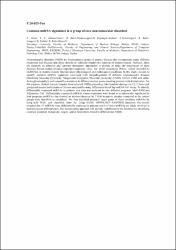Common miRNA signatures in a group of rare neuromuscular disorders

Göster/
Erişim
info:eu-repo/semantics/openAccessTarih
2018Yazar
Aksu, E.Akkaya-Ulum, Y. Z.
Balci-Peynircioglu, B.
Dayangac-Erden, D.
Yuzbasioglu, A.
Bakir-Gungor, B.
Talim, B.
Balci-Hayta, B.
Üst veri
Tüm öğe kaydını gösterKünye
FEBS OPEN BIO Volume: 8 Pages: 467-467 Supplement: 1 Meeting Abstract: P.24-023-TÖzet
Neuromuscular disorders (NMD) are heterogeneous group ofgenetic diseases that encompasses many different syndromes anddiseases that either directly or indirectly impairs the function ofskeletal muscle. However, there are currently no effective andcommon therapeutic approaches to prevent or delay the progres-sion of these diseases. Recent studies revealed important regula-tory roles for small noncoding RNAs, called microRNAs(miRNAs), in skeletal muscle function under physiological andpathological conditions. In this study, we aim to identify com-mon miRNA signatures associated with etiopathogenesis of dif-ferent neuromuscular diseases (Duchenne Muscular Dystrophy,Megaconial Congenital Muscular Dystrophy (CMD), UllrichCMD and alpha-dystroglycanopathy), each caused by mutationsin different nuclear genes encoding proteins with distinct roles.For this purpose, skeletal muscle biopsies from selected NMDspresenting mitochondrial damage (n=12, 3 from each group)and control individuals (n=3) were analyzed by using Affyme-trix GeneChip miRNA 4.0 Array. To identify differentiallyexpressed miRNAs in patients, raw data was analyzed by twodifferent programs, MeV-SAM and Affymetrix TAC. Differen-tially expressed miRNAs whose expression were found to be sta-tistically significant by both programs (miRNAs that showed anincrease/decrease by 2 fold in patient samples compared to thecontrol group) were identified as candidates. We then identifiedpotential target genes of these candidate miRNAs by using miR-Walk and classified them by using GENE ONTOLOGY-PANTHER databases. Our results revealed that 17 miRNAswere differentially expressed in patients and 5 of these miRNAsare likely involved in skeletal muscle differentiation. Our com-monality approach will provide contribution to the literature byidentifying common potential therapeutic targets and/orbiomarkers related to different rare NMDs.

















